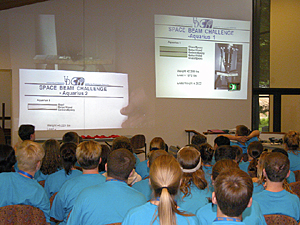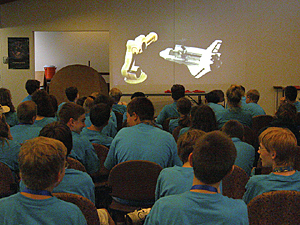

UDAILY is produced by the Office of Public Relations
150 South College Ave.
Newark, DE 19716-2701
(302) 831-2791
|
 |
Budding engineers meet 'Space Beam Challenge'
10:55 a.m., Aug. 18, 2003--Many young people have dreams about exploring the universe and perhaps working on a futuristic space station such as the ones featured in television programs like “Star Trek” and “Deep Space Nine.”
Helping provide students with a practical approach to realizing their hopes of one day working in outer space is the “Space Beam Challenge,” one of many summer activities offered for children at UD.
Sponsored by SAMPE-UD (Society for the Advancement of Materials and Process Engineering—University of Delaware Student Chapter) and the Center for Composite Materials (CCM), the two-day event offered future space scientists, engineers, writers and artists a hands-on experience in constructing materials similar in concept to those being used in cutting-edge extraterrestrial engineering projects, such as the new international space station.
 |
| Finished space beams were subjected to a three-point bending test at UD’s Center for Composite Materials. Here students watch videos of the tests to see how their creations measured up. |
Recently, about 48 seventh- through ninth-grade student cadets from the Delaware Aerospace Academy participated in the Space Beam Challenge as part of a weeklong event where participants lived on campus and took part in a variety of educational and recreational experiences, including visits to the Dover Air Force Base and a rocket engine manufacturing plant in Elkton, Md.
Students also visited CCM’s Composite Manufacturing Science Laboratory, where they were given an overview of composite materials, as well as a visit to the mechanical testing laboratory, where thermal camera, laser cutter and tow-place robot demonstrations were given.
During the Space Beam Challenge, participants divided into groups to design and assemble a space beam strong enough to win the weight-to-load ratio contest. An introductory session gave graduate students from SAMPE and CCM an opportunity to explain the concepts involved in composite sandwich structures. Then, students got down to the business of designing and building composite space beams.
Wearing protective gloves, aprons and goggles, the teams worked in 15-to-20 minute sessions in the area just above Pencader Commons on UD’s Laird Campus. The kits supplied by SAMPE included foot-long sections of steel, aluminum, glass-fiber-reinforced epoxy and carbon/epoxy for face sheets. Core materials consisted of high-grade engineering foam, blue polystyrene foam and balsa wood.
The moment of truth came when finished space beams were subjected to a three-point bending test using CCM’s Instron testing machine. As students watched to see how their creations measured up, the entire test process was videotaped. Before students learned the results, they were asked to explain why they chose the particular design for their beam.
This year’s winning team, Anatares 1, constructed its beam from carbon fiber-reinforced epoxy face sheets with a balsa wood center, with a load-to-weight ratio of 5544. The winners were awarded a CCM bag in recognition of their achievement, Xiao Gao, a materials science and engineering graduate student and president of SAMPE-UD, said
“This helps the kids gain a better understanding of composite materials,” Gao said. “The process also teaches students just how important the load-to-weight ratio is in fabricating materials suitable for aerospace applications.”
Gao also noted that none of the top three beams contained any metal materials, a fact that emphasizes the importance of composite materials for low-weight, high-strength applications.
The designing and building of space beams, as well as the building and firing of individual rockets, are among the most popular camp activities, Gao said.
Mike Metzler, 12, who will be a seventh-grader this fall in Salisbury, Md., Middle School, said he became interested in aerospace activities as a result of a third-grade class project.
“The theme was something like ‘why do you want to be an exemplary cadet,’” Metzler said. “I wrote something about launching a dream, and I was picked for the project.”
Metzler’s favorite museum visit during this year’s camp was a trip to the Dover Air Force Base, which he described as both interesting and informative.
Taj Sarin, 12, who will be entering the seventh grade at Garnett Valley Middle School in Glenn Mills, Pa., was impressed by the laser operation and infrared camera demonstration during a visit to the CCM testing facility.
“My mom found out about the camp, and I was very excited about coming here,” Sarin said. “I learned a lot of neat stuff, and I enjoyed going to the CCM lab and the Dover Air Force Base.”
For three students from the H.B. du Pont Middle School in Hockessin, the camp provided an opportunity to work as a team while learning about the science of composite materials and aerospace construction.
“The camp was a lot of fun, but you also learned a lot by doing things,” Michelle Barineas, 12, who will be entering the seventh grade there this fall, said. “I like the rockets—every year there is something different.”
 |
| Students see a demonstration of Space Shuttle robot technology. |
Fellow H.B du Pont seventh grader, Emily Guillen, 12, was not sure what to expect on her first visit to UD. “My older brother told me we were going into outer space when we got to camp,” Montanaro said. “He likes to trick me. My favorite activity at camp is building the rockets.”
Alyssa Montanaro, 13, who is going into the eighth grade, enjoyed the hands-on approach to rocket building and space beam construction.
“I like to build kits,” Montanaro said. “I enjoy building bridges made out of balsa wood. When you are done, they hang a bucket from the finished project and see how much sand can be poured into it before the bridge starts to buckle or break.”
Some former campers and counselors return each year to volunteer their time and expertise as copilots, captains and commanders, including Phillip Oyerly, who took part in the very first camp in the early 1990s.
A graduate of Embry-Riddle Aerospace Aeronautical University in Daytona Beach, Fla., Oyerly is now pursuing an MBA at UD.
“This is my seventh or eighth year of working here,” Oyerly said. “I was a cadet at the very first camp—and I was in the first group of copilots and the first group of captains.”
Oyerly said camp size usually ranges from 45 to 60 people, and that while students seem to enjoy whatever activity they are doing, instructors also try to impress cadets with the more academic aspects involved in the use of composite construction materials.
“This is more like an exercise in engineering, or a lesson in beam theory,” Oyerly said. “We also let students know that any failures that occur during testing are a normal part of the engineering process.”
Crediting his positive experiences both as a student and a counselor with the academy as helping to influence his choice of pursing an aerospace-related career, Oyerly said he encourages students to consider making similar choices.
“Cadets do not fully realize the potential they have—but the camps let them do that,” Oyerly said. “I also tell them that even if they are not interested at present, they may change their mind in the future.”
Past SAMPE president and third-year academy volunteer Witchuda Suwanwatana, a graduate student in materials science and engineering at UD, said she enjoys the enthusiasm of the students and their ability to adapt to design challenges that change with each academy.
“We never have the same beam design during any one summer, but we encourage them to work as a team in coming up with their best design,” Suwanwatana said. “Their imagination and their thinking process impress me and keep me coming back year-after-year.”
Article by Jerry Rhodes
Photo by Kevin Quinlan
|
 |

[an error occurred while processing this directive]
|

